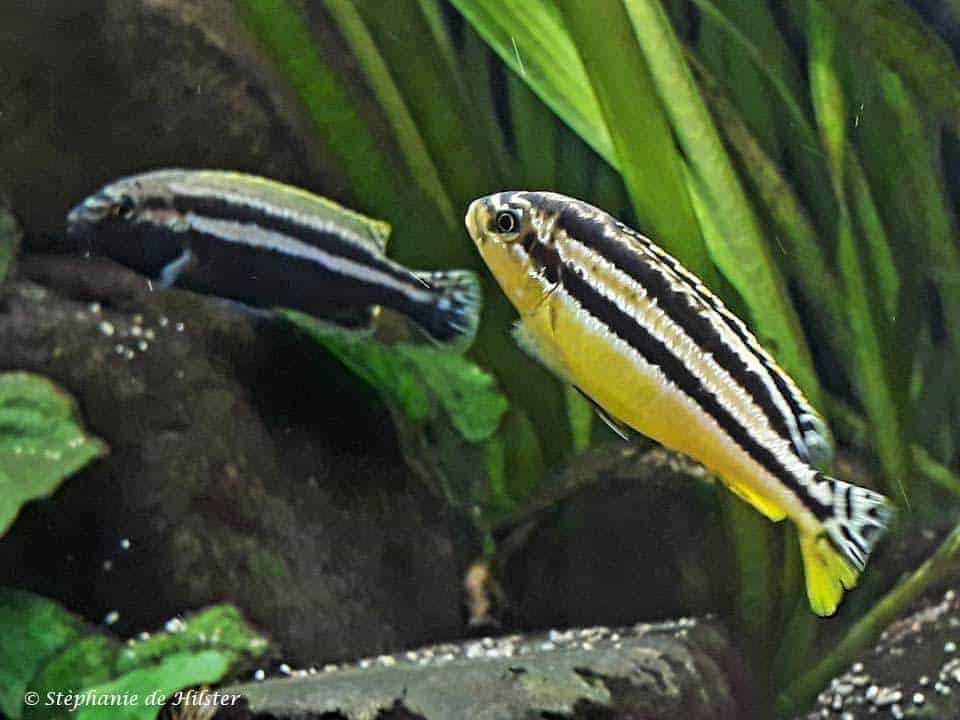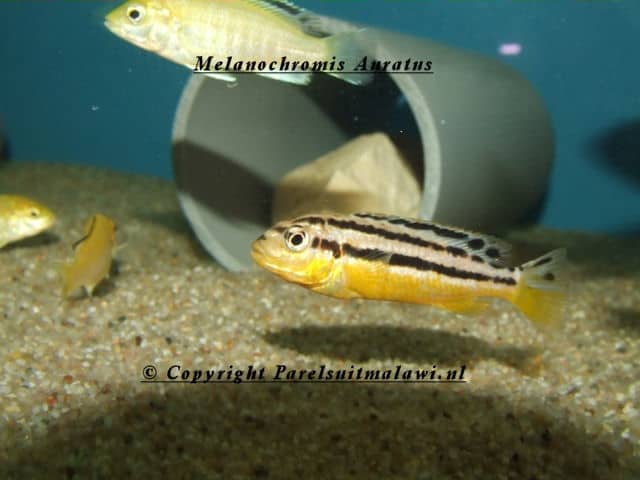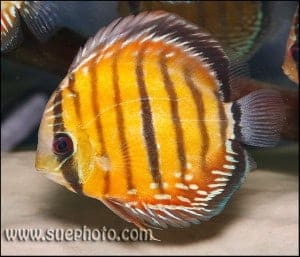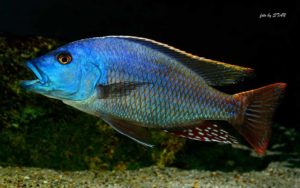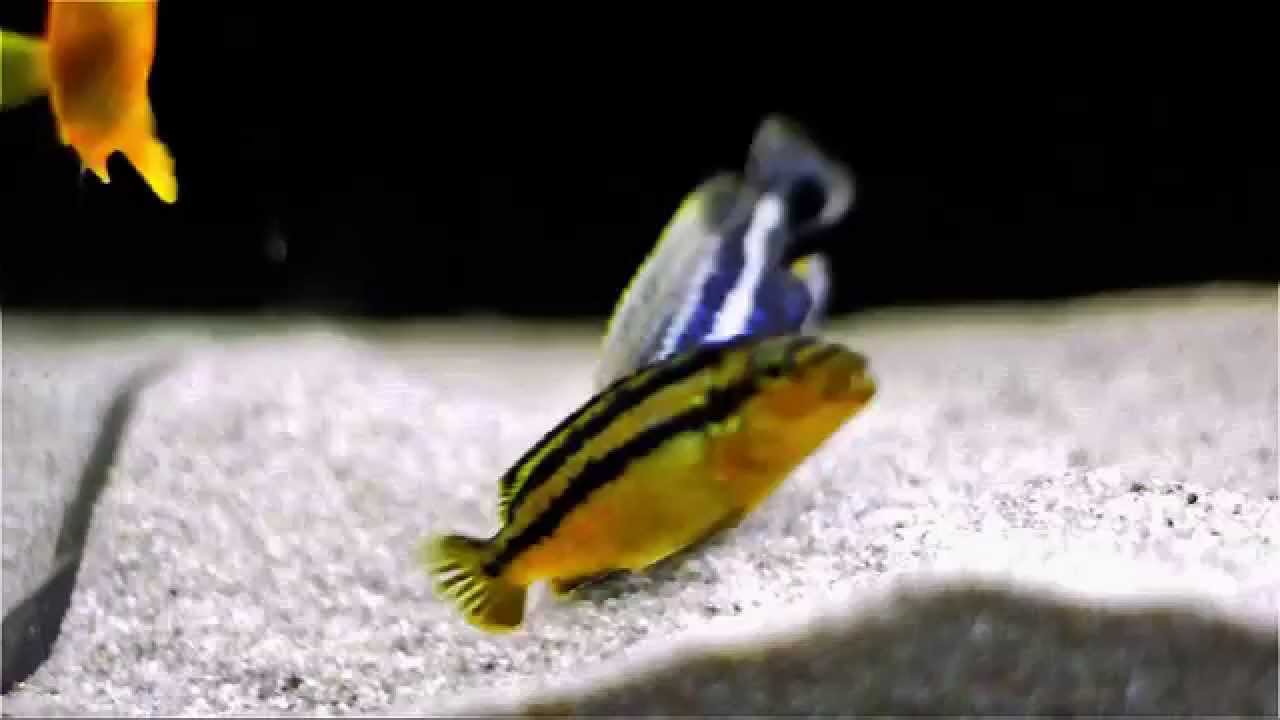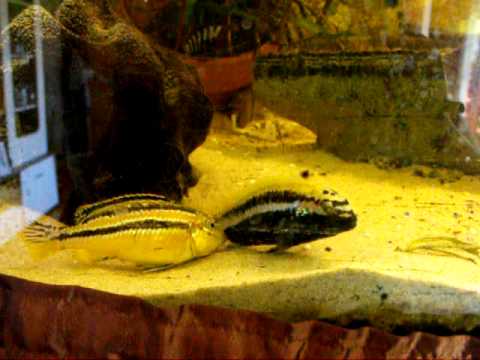Melanochromis auratus – Golden Mbuna
Melanochromis auratus was first described by George Albert Boulenger in 1897. This fish belongs to the family Cichlidae. The species name Melanochromis can be broken down into two parts: “Melano” means black and “chromis” means fish, referring to the dark fins and melanin pattern of the fish. The species name Auratus means golden, referring to the golden color of the females and juveniles.
Synonyms:
- Chromis auratus
- Pseudotropheus auratus
- Tilapia aurea
Description
General description:
Melanochromis auratus has a slender and elongated body that is slightly flattened. The head and flanks of females and juveniles are golden yellow with two dark bands along the length, with a white stripe on either side of the dark bands. Males have black-brown flanks with two yellow-white, bluish-shiny longitudinal bands. The fins of females are golden yellow, while males have black fins with a blue or yellow edge. The maximum length of males is about 12 centimeters, while females grow to a maximum of 10 centimeters.
Differences between males and females:
- Physical differences: Males are larger and have a darker color pattern with light blue or yellow stripes, while females and juveniles are golden yellow with black stripes.
- Behavioral differences: Males are very aggressive and territorial, especially towards other males and conspecifics. Females are less aggressive and can change their color to resemble males when no male is present.
Behavior and temperament:
Melanochromis auratus is an aggressive and territorial fish. They live solitary or in small groups and are very intolerant of conspecifics and similar species. They are bottom dwellers and swim mainly in mid-waters.
Life expectancy:
In the wild they can live up to 8 years, while in a well-maintained aquarium, they can live up to 10 years.
Biotope
Natural Distribution:
Melanochromis auratus is found along the rocky shores of the southern part of Lake Malawi, at locations such as Jalo Reef, Crocodile Rock, Chipoka, Rifu, Senga Point and Nkhomo Reef.
Natural habitat:
They live in rocky habitats with little underwater vegetation. The edges of the water are usually bare. The bottom consists mainly of rocks and sand. They have few natural enemies and feed mainly on algae and small invertebrates.
Diet
Diet in the wild:
Melanochromis auratus feeds mainly on algae that they pick from rocks (aufwuchs), but also on plankton and small crustaceans.
Diet in the aquarium:
In the aquarium they can be fed a diet of green food such as spirulina flakes, flake food, granulate, artemia, mysis and shrimp mix.
The Aquarium
Aquarium size:
The aquarium should be at least 150 cm long with a capacity of 400 liters, preferably much larger if you want to keep multiple pairs.
Decoration:
The aquarium should be decorated with lots of rocks and hiding places where the females can hide from the intrusive males. Use sand or fine gravel as a substrate.
Water parameters:
The best water parameters are a pH of 7.5-8.5, a total hardness of 10-25 °DH and a temperature of 22-26°C.
Compatibility:
They can be kept well with other mbuna species such as Pseudotropheus, Labidochromis and Labeotropheus, but not with other Melanochromis species to avoid hybridization.
Breeding aquarium and conditioning
Melanochromis auratus can be bred in a normal aquarium. A special breeding aquarium is not necessary. The water should be clean and well filtered, with a temperature of 26-27°C. Condition the fish with a diet of live and frozen food such as artemia and mysis.
The spawn
During spawning, the fish’s colors become more intense. As soon as the male notices that a female is ready to mate, he tries to court her. He swims right in front of her. He spreads his fins wide. With trembling movements, he lures her to a spot in the sand.
The pair swims around each other just above the sand. The female lays one or more eggs in the sand. They continue to circle each other, with the male fertilizing the eggs. The female turns around and takes the egg in her mouth. She will hatch the egg in her mouth.
The number of eggs varies from 10-30, depending on the size of the female.
Raising the fry
The eggs hatch after about three to four weeks. The female does not yet release the newly hatched fish. They feed on their egg yolk sac in her mouth. Only about 20 to 21 days after the eggs have been defecated does she release the young fish. The first food for the young consists of artemia, cyclops and finely crushed dry food.
If you release the fry into an aquarium with adult Malawi Cichlids, they are often used as food. If you want to raise more fry, you can catch the female from the aquarium around day 17. Place her in an aquarium of at least 40 centimeters long. Decorate this aquarium with some sand on the bottom and a few rocks where she can hide. If she releases the fry around day 21, she will not eat the fry right away. You will then have enough time to put the female back in the large aquarium.
Particularities
Melanochromis auratus is one of the first cichlids to be exported from Lake Malawi and is very popular with cichlid enthusiasts for their striking color patterns and interesting behavior. However, they are very aggressive and require careful planning when setting up an aquarium.
Conclusion
Melanochromis auratus is a beautiful but aggressive cichlid that is suitable for experienced aquarists. They require a well-established aquarium with plenty of hiding places and a diet rich in plant material. Although they can be challenging to keep, they offer great rewards for those willing to give the necessary care and attention.
Video
Author
John de Lange
Copyright images
Coby
Stèphanie de Hilster

